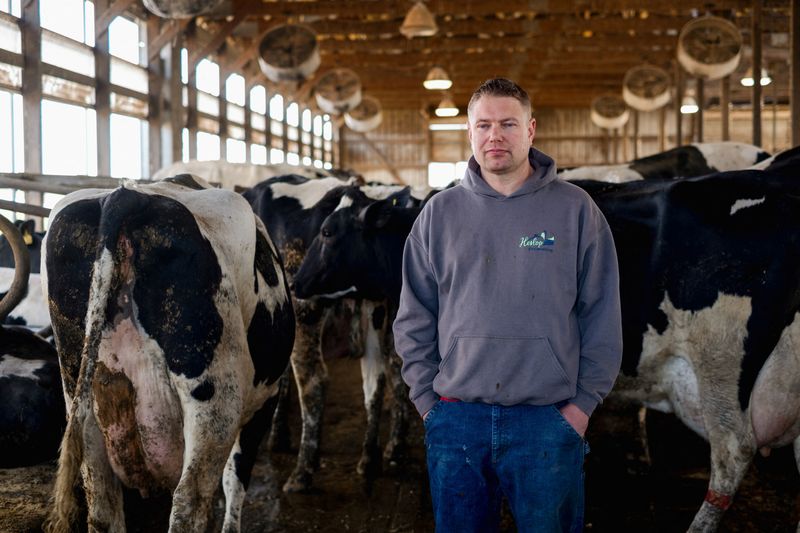By Tom Polansek
CHICAGO (Reuters) -Dairy farmers in the United States are raising their defenses to try to contain the spread of bird flu: banning visitors, cutting down trees to discourage wild birds from landing, and disinfecting vehicles coming onto their land.
South Dakota on Thursday became the eighth state to find highly pathogenic avian influenza (HPAI) in a dairy herd, after the U.S. Department of Agriculture reported infections in North Carolina, Texas, Kansas, Ohio, Michigan, Idaho and New Mexico.
While the first cases appear to have been introduced to herds in Texas and Kansas by wild birds, the USDA said transmission among cattle was also possible. Agricultural officials in Michigan and Ohio said infected herds in those states received cattle from Texas.
Reuters spoke to seven dairy farmers in five states who said they are reinforcing safety and cleaning procedures, with three producers exceeding government recommendations.
"Think of our farm now as a gated community for cows," said Karen Jordan, who raises about 200 dairy cattle in Siler City, North Carolina. "Only the most essential person can get past the gate."
Even before North Carolina's outbreak, Jordan, 64, said she was limiting visitors who could unintentionally carry in contaminated bird droppings on boots or vehicles. She also started chopping down about 40 small trees to avoid attracting wild birds during spring migration.
The first confirmed case in a dairy herd on March 25 and the second human case in two years on April 1 have heightened concerns in the U.S. about the spread of the virus to animals and people. Bird flu has decimated poultry flocks globally since 2022 and infected mammals ranging from seals and foxes to skunks.
The U.S. Centers for Disease Control and Prevention said the risk to humans remains low, but has asked states for plans to test and treat potentially impacted farm workers.
REDUCED MILK PRODUCTION
While bird flu is lethal to poultry, cows appear to recover. The outbreaks in dairy herds primarily affect lactating cows, the USDA said, reducing milk production and prompting farmers to isolate sick animals while keeping their milk out of the food supply.
U.S. milk production grew to nearly $60 billion in 2022. Dairy farmers now fear a drop in demand for milk and cheese, after the USDA reported bird flu in unpasteurized milk samples, though agricultural officials say pasteurized milk is safe.
Futures prices for milk dropped as infections expanded last week, before the market rebounded. Beef cattle futures also plunged on fears of reduced demand, although there have been no confirmed cases of the virus in cattle raised for meat.
The USDA has not issued quarantine orders for infected dairy herds but last week recommended minimizing the movement of cattle and testing milk samples from lactating cows if they must be moved. Producers were also urged to monitor livestock for illnesses; isolate newly added cows; and keep wildlife and domestic pets like cats away from farm buildings to reduce the spread of the virus.
The agency advised farmers to pay "special attention to good milking practices, such as equipment disinfection." In interviews with Reuters, animal-health authorities raised the possibility that milking machines may play a role in spreading infections among cows, though that has not been confirmed.
"We cannot rule out other possible modes of HPAI transmission, including equipment," the USDA said in an email.
Seven state and industry officials said farmers face challenges because of uncertainty over how the virus is spreading and the exposure of open-aired barns to wild birds.
Idaho, North Carolina and more than a dozen states that have not confirmed cases in cattle imposed additional requirements on shipments to protect their herds.
Nebraska, the second-biggest U.S. cattle producer after Texas, on April 1 began requiring producers to obtain permits to bring breeding dairy cows into the state so officials can better track animal movement.
Texas advised producers to monitor their herds and keep sick animals at home. Kansas recommended limiting the movement of cattle but has not mandated extra restrictions, said Justin Smith, the state's animal health commissioner.
"These dairies have got a lot at stake," Smith said in an interview. "If they have concerns about that movement, they need to reassess it, versus me mandating a reassessment."
Yogurt maker Danone said it is advising suppliers to isolate cattle that may have been exposed to the virus and report any cases to local officials.
DISINFECTING TIRES
In Fort Branch, Indiana, Steve Obert, 61, is requiring drivers to spray truck wheels with disinfectant before he allows them on his farm. He raises about 1,200 cows that produce milk for Dairy Farmers of America, a cooperative of more than 6,000 farms.
Obert, who is also executive director of the industry group Indiana Dairy Producers, said bigger farms face increased risks, in part because they maintain large stocks of feed that attract wild birds that could be carrying the virus.
Big dairies also often ship heifers, or female cows that have not yet given birth, to other states to be impregnated before returning to their home farms for milking, he said.
Obert, who ships cows to Kentucky, said he trusted Indiana's decision not to impose new restrictions on cattle movement, but: "As a producer, you sit at the edge of your seat thinking, 'Gosh, I hope we're not behind.'"
In Rockford, Illinois, 43-year-old farmer Brent Pollard, who supplies milk to cooperative Prairie Farms, is keeping a calf he bought for his daughter from Wisconsin in isolation for 21 days.
No cases have been reported in Wisconsin, but Shelly Mayer, 58, said she is watching for dead birds on her dairy outside Milwaukee and working to keep water tanks clean of bird droppings and other contaminants.

Farmers are also trying to keep wild birds away from feed supplies but it is difficult.
"The dairy farm is like a giant bird feeder," said Jamie Jonker, chief science officer for the National Milk Producers Federation.